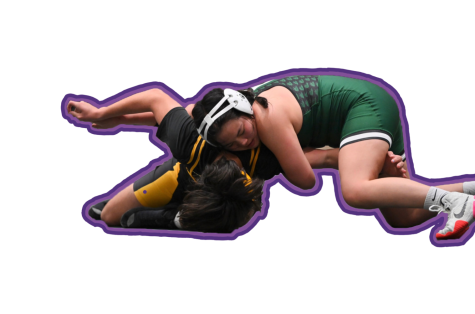Losing to Win
February 24, 2023
Athletes are familiar with doing anything it takes to get better at their sport. Early morning practices, difficult workouts, and long hours are devoted to improvement by athletes across all sports.
However, for many people, their quest for athletic success is not constrained to just training hours. Athletes stretch and do physical therapy to keep their muscles in prime shape. They watch films about their sport to learn new strategies. And for some, everything they eat becomes a part of their athletic regimen as well.
Many athletes watch their diets, making sure to eat healthily and consume enough protein to build strength and endurance for their season. But for athletes who row, box, or wrestle, body weight directly affects the entire system of play, so diet makes an even bigger impact than in other sports.
The notion of dieting in these sports means more than simply what or how much you ingest. Dieting in this context can often involve “cutting weight” in either the short-term or long-term, in preparation for a match or race.
The cutting for wrestling can resemble that of the cutting in the weightlifting and bodybuilding industry: the focus is on losing fat and preserving muscle. Arpan Das, a sports medicine doctor, elaborates on this.
“Cutting weight for weight class requirement sports such as wrestling, boxing, and bodybuilding is the process of significantly reducing your calorie intake while increasing your calorie output in order to create a calorie deficit,” Das said. “When done successfully, this will result in a gradual, consistent loss of fat mass while muscle mass stays intact.”
However, cutting weight can be a controversial, sensitive subject because of its potentially harmful side effects –– both physical and mental.
“It’s tiring,” an anonymous wrestler said. “You’re thirsty, you’re hungry but you can’t eat.”
In society today, it has become increasingly desirable to seek ways to lose weight, whether due to health reasons, societal pressure, or personal drive. When an individual wants to lose weight, they tend to focus on long-term, sustainable loss. This means keeping a slight caloric deficit of 200-500 calories; but no more than 10% of one’s typical calorie intake, for several months or even a couple of years (depending on the total weight they want to lose).
The notion of cutting weight in the bodybuilding industry generally is more short-term than the average person. For example, athletes will “bulk” (eat in caloric excess) and prioritize weight lifting to gain muscle. Then, around two to four months before a bodybuilding competition, these athletes will increase cardio and move their diet into a caloric deficit, “cutting weight”. Similarly to those who want to lose long-term weight, this deficit is no more than 400-600 calories. The focus is on losing the extra fat from the “bulking” period.
However, cutting for wrestling can also look a little different than both of these methods: it can mean “making weight.” This notion is more short-term than the previous methods. Cutting means dropping a lot of weight (especially weight taken in by drinking fluids, called water weight) in the days or even hours before the “weigh-in” of a competition in order to be placed in a lower weight class, thus gaining a competitive advantage over an opponent.
Conversely, simply making weight involves minimal loss of weight within a small range of a few pounds. Thus, wrestlers not participating in drastic weight loss will maintain a normal body weight slightly above or the same as their competition weight.
In boys wrestling, there are currently 14 weight classes approved by the CIF: 106, 113, 120, 126, 132, 138, 145, 152, 160, 170, 182, 195, 220, and 285 pounds. These numbers were determined in 1999 by analyzing data in order to have approximately 7% of wrestlers in each weight class. Players are weighed and placed into different weight classes before each meet so each athlete is competing with someone comparable to their own weight, promoting fairness and safety in the sport.
With this rule in place, wrestlers must compete at the weight they weigh in on the day of the meet. Thus, it is desired to be as close as possible to the competition weight cutoff, but not over. If you are over the designated weight class, you cannot compete in that class. You would then be forced to compete in the next highest weight class. This would almost certainly mean a loss in the match because of the weight deficit of the athlete at the high end of the spectrum versus the athlete at the lower end, so oftentimes those who do not make the weight class choose not to compete instead. Furthermore, because the varsity team can only have one athlete per class, not making weight can lead to the loss of a varsity spot.
“If you weigh in at a meet and you’re not light enough, then you don’t wrestle,” an anonymous wrestler said. “Or, if you are weighing in and barely over the weight –– like 0.1 pound –– then you go run sprints for the next five minutes [to sweat it off] and then weigh in again.”
Like this athlete mentioned, people can take various measures to ensure that they weigh the highest for their weight class, but not over, in order to gain the largest competitive advantage over the opponent.
In recent years, the strategy of weight-cutting has become more prevalent for many wrestlers. Due to this, tools have been created to aid the assessment of weight for a specific athlete, namely, the weight certification process. This is an attempt to mitigate the extreme forms of unhealthy weight loss behavior. Jonathan Kessler, who has coached wrestling for 17 years, 8 of them being at Paly, has seen the implementation of these tools first-hand.
“Prior to the 2000s, wrestling didn’t have a weight certification process,” Kessler said. “Since then, the weight certification process determines how much a wrestler can drop within a 3 to 4-month season.”
Weight certification is used at the beginning of the season to measure wrestlers at their natural weight and to determine a healthy goal weight for them to strive for during the season. Kessler expands on the process itself which is much more intricate.
“The wrestlers get weighed in and their height is measured,” Kessler said “Then they use a wand to test body fat in the stomach, scapula, and tricep. From there, their info goes into a formula to see the lightest weight they are allowed to wrestle.”
This process is important because it helps wrestlers and their coaches decide what weight class will best fit their current body composition. The weight certification test calculates the healthy weight fluctuation of a wrestler based on height, weight, and body fat percentage. Before its implementation in the 2000s, harmful forms of extreme weight cutting such as drastic dehydration and starvation were used in wrestling, often resulting in health issues. This test helps prevent dangerous forms of cutting to make the sport safer for these athletes.
Despite the existence of this process, athletes still desire to have the highest weight below their competition weight. This leads to the manipulation of their weight leading up to the competition. It can be done in different ways, some focused on more long-term fat loss (similar to the cutting in the bodybuilding industry) and others focused on more short-term water-weight and food-weight loss (more particular to wrestling and other combat sports).
The first method focuses on longer-term fat loss. In order to lose fat, athletes, like bodybuilders who cut before shows, will live in a caloric deficit for a few weeks leading up to the competition in order to minimize body fat levels. While being in a caloric deficit, athletes will maintain muscle if done properly, but extreme caloric deficits can also lead to muscle loss. A primary goal for this type of longer-term weight loss is to lose body fat, helping them maximize their own strength level for their specific weight class.
The second method is more short-term and particular to combat sports. It focuses specifically on water weight loss. This can be done by burning through glycogen stores in your body. One can do this by exercising on an empty stomach for approximately 80 minutes. Glycogen is made by connecting glucose (sugar) molecules together. When the body has extra glucose, those chains are stored in the liver, so when the body needs a quick boost of energy, glycogen is broken down into simple glucose and released into the bloodstream as fuel for the cells. When working out on an empty stomach, the body burns through glycogen stores quickly. This forces your body to then turn to burning fats. This process can help one drop weight at rapid levels.
Losing water weight and particular food weight can also be done by weighing the physical food and sweating off the water. Heat and exercise both help you release water by sweating, therefore wrestlers cutting attempt to sweat as much as they can, attempting to lose the physical presence of food and water as opposed to actually losing muscle and fat.
“I would wear five layers to work out,” an anonymous player said. “[This] sweated out all the water weight.”
Similarly, some athletes try to add minimal weight in the form of food to keep their body weight down.
“I was weighing my food,” the anonymous player said. “It wasn’t calories or anything, it was the physical weight. I had a kitchen scale and, for example, would weigh an apple. I would then take a bite and weigh the apple to see how much I ate and then calculate it and take another bite. Take another bite, see what it was.”
Paly graduate and wrestler Dara Heydarpour explains the ways he combines both methods (long-term fat loss and cutting water weight) in the healthiest, most effective way as a current wrestler at Rochester Institute of Technology.
“The most efficient way [to cut] is to be in a calorie deficit until [you are] as skinny as healthily possible and then hydrate a bunch two days before,” Heydarpour said. “Then work out until all the water is out of your system.”
For any method of cutting, athletes must focus on executing it in a healthy way to ensure their physical and mental well-being. This, according to the aforementioned sports medicine doctor, Das, means making it clear what is realistic and healthy as well as what is extreme and unnecessary.
In terms of the long-term technique, this means dropping weight in a slow and sustainable manner and focusing on preserving muscle while doing so.
“Ideally, athletes should avoid trying to lose more than 1kg (or 2.2lbs) a week, in which case they are likely losing significant muscle mass too and affecting athletic performance,” Das said.
In terms of short-term weight loss, specifically water weight loss, this means not taking extreme measures that detrimentally impact health.
“Short-term extreme tactics such as extreme water manipulation (using saunas, diuretics or salt cutting to eliminate body water, laxatives to cause nutritional malabsorption or medication to increase metabolic rates such as thyroxine, catabolic agents and steroids) absolutely need to be avoided as they come with significant health risks for an athlete, especially increasing risk of heart attacks, kidney and liver failure,” Das said.
Dr. Stacey Kofman, the sports medicine teacher here at Paly, agrees with Das, noting that these extreme short-term measures can hurt immediate performance.
“[Wrestlers may experience] dehydration, increased rate of injury, and decreased power/muscle output,” Kofman said.
While these side effects may show up almost immediately, there can also be more severe side effects that negatively impact the athlete later in life.
“[There can be] changes to the thyroid, making it harder to properly lose weight due to the cycling of adding and needing to take off weight,” Kofman said.
Furthermore, there are metabolic changes and chances of developing eating disorders, potential cardiac compromise, and long-lasting injuries. These compromising physical effects are enlarged by possible fogginess or confusion that wrestlers can experience in their daily lives due to weight cutting and lack of food and water.
However, as aforementioned, these effects can be avoided if wrestlers approach weight cutting in a more realistic, sustainable, healthy way. It is important that wrestlers work closely with their coaches and teams when cutting and making weight to ensure that it is done in a safe and sustainable manner. Kessler agrees, making an emphasis on the prioritization of safety.
“Of course we don’t force anyone to go down [in weight classes], “Kessler said. “Once the results [of the weight test] come in, wrestlers are typically allowed to lose [up to a pound every 3 days]. This is so wrestlers lose weight gradually and not all at once. Wrestlers are not allowed to compete lower than the weight that was originally calculated.”
The athletes feel the same way, noting that focusing too much emotional and intellectual energy on cutting takes away from the sport. As the athletes agree, the simplest approach of maintaining a healthy diet with balanced macronutrients, is the best, as it tones the body but maintains a healthy metabolism.
“The healthiest approach is to eat cleanly and workout multiple times a day,” Heydarpour said.
Heydarpour notes that aggressive cutting is not encouraged in the sport and that most wrestlers instead take the more sustainable approach –– of healthy, clean eating –– in order to make their weight rather than excessive cutting. While cutting can provide an advantage in performance, minimal weight loss to make weight can be much healthier for athletes in the long term.
While wrestling does require high amounts of skill and technique, this strength advantage can make a difference in the outcome of a match. Even so, the effects of cutting weight can differentiate from person to person.
This approach is seen here at Play, where the wrestling team has been one of the most decorated teams at Paly, producing numerous national winners. Since they are a team full of dedicated and hard-working athletes, many do everything they can to advance that competitive advantage, including monitoring their eating. However, not everyone chooses to cut weight.
“Almost every coach will let you decide what weight you want to go,” Heydarpour said. “If a person decides to drop a bunch of weight the wrong way and develops a side effect, that’s not the coach’s fault. If someone cuts weight the right way every time none of the long-term effects would take place”
The stereotype that surrounds wrestlers cutting extremely can bring a negative connotation around participating in the sport. But in reality, most wrestlers at Paly solely attempt to make weight rather than the drastic weight loss processes that many people believe are commonplace.
“It’s not like the majority of kids who wrestle cut weight dramatically, and that needs to be clarified,” said the anonymous wrestler.
Kessler agrees that not all wrestlers cut in aggressive, harmful ways, adding instead that each athlete does better with a different strategic weight plan that keeps them at a healthy, optimal weight.
“Some wrestlers are better off not dropping weight classes so they feel more energized,” Kessler said. “Some wrestlers can wrestle on an empty stomach and be fine.”
Overall, weight is a big factor in wrestling. And while some athletes take this to a harmful extreme form of cutting, here at Paly, sustainable healthy methods are encouraged.
In the end, athletes need to remember that nutrition and weight are only one aspect of athletics and that showing up to practice and putting in consistent work day after day will often make more of a difference than the three bites of apple two weeks before the next big match. One match won’t affect your future. Preserving your health and safety will.












